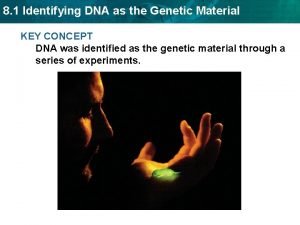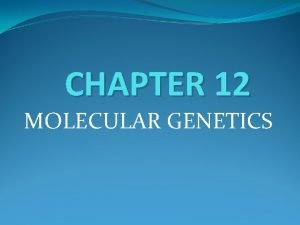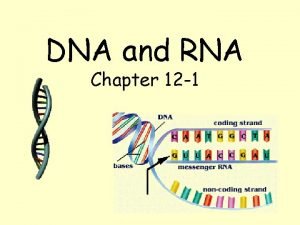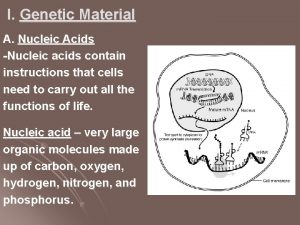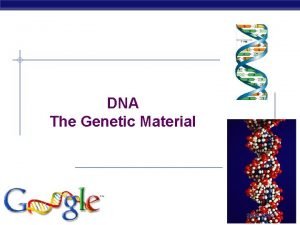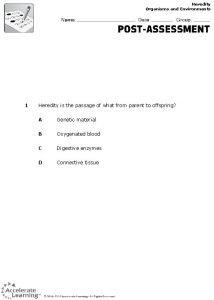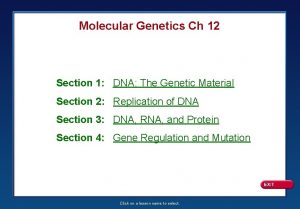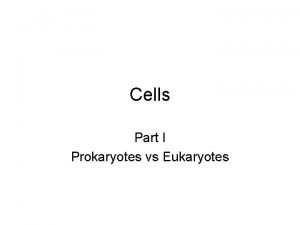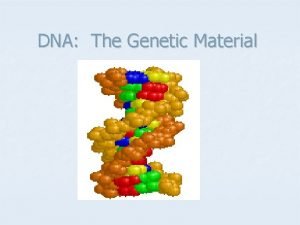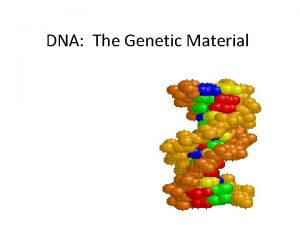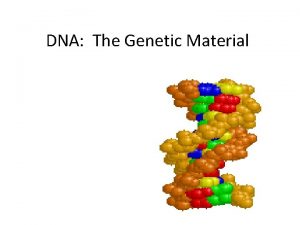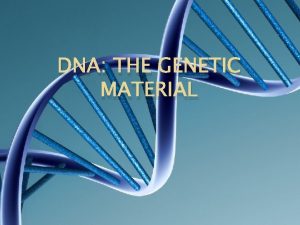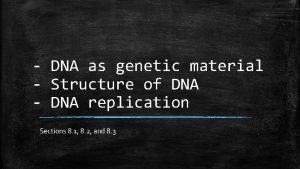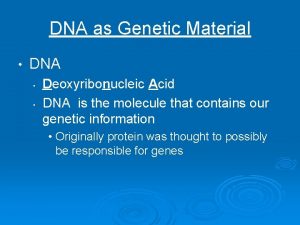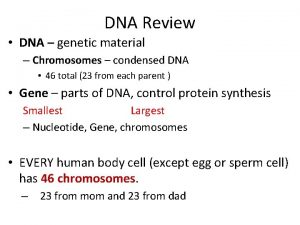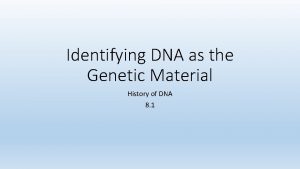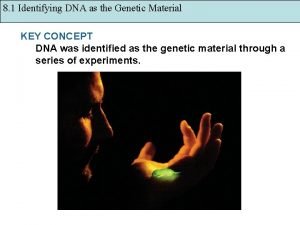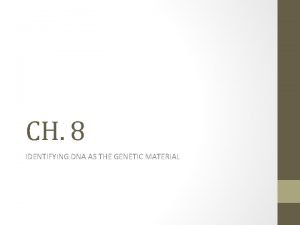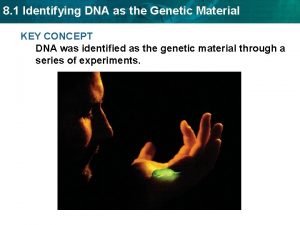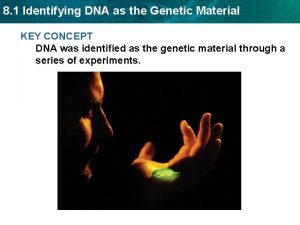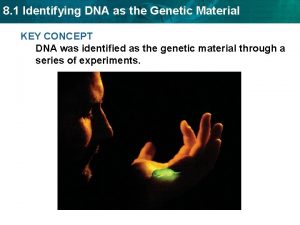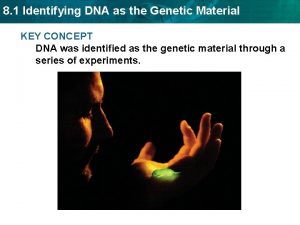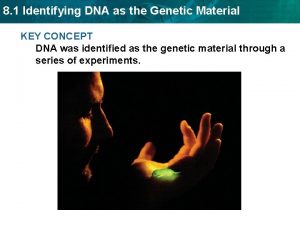8 1 Identifying DNA as the Genetic Material



















































- Slides: 51

8. 1 Identifying DNA as the Genetic Material KEY CONCEPT DNA was identified as the genetic material through a series of experiments.

8. 1 Identifying DNA as the Genetic Material Griffith finds a ‘transforming principle. ’ • Griffith experimented with the bacteria that cause pneumonia. • He used two forms: the S form (deadly) and the R form (not deadly). • A transforming material passed from dead S bacteria to live R bacteria, making them deadly.

8. 1 Identifying DNA as the Genetic Material Avery identified DNA as the transforming principle. • Avery isolated and purified Griffith’s transforming principle. • Avery performed three tests on the transforming principle. – Qualitative tests showed DNA was present. – Chemical tests showed the chemical makeup matched that of DNA. – Enzyme tests showed only DNA-degrading enzymes stopped transformation.

8. 1 Identifying DNA as the Genetic Material Hershey and Chase confirm that DNA is the genetic material. • Hershey and Chase studied viruses that infect bacteria, or bacteriophages. – They tagged viral DNA with radioactive phosphorus. – They tagged viral proteins with radioactive sulfur. • Tagged DNA was found inside the bacteria; tagged proteins were not.

8. 1 Identifying DNA as the Genetic Material KEY CONCEPT DNA structure is the same in all organisms.

8. 1 Identifying DNA as the Genetic Material DNA is composed of four types of nucleotides. • DNA is made up of a long chain of nucleotides. • Each nucleotide has three parts. – a phosphate group – a deoxyribose sugar – a nitrogen-containing base phosphate group deoxyribose (sugar) nitrogen-containing base

8. 1 Identifying DNA as the Genetic Material • The nitrogen containing bases are the only difference in the four nucleotides.

8. 1 Identifying DNA as the Genetic Material Watson and Crick determined the three-dimensional structure of DNA by building models. • They realized that DNA is a double helix that is made up of a sugarphosphate backbone on the outside with bases on the inside.

8. 1 Identifying DNA as the Genetic Material • Watson and Crick’s discovery built on the work of Rosalind Franklin and Erwin Chargaff. – Franklin’s x-ray images suggested that DNA was a double helix of even width. – Chargaff’s rules stated that A=T and C=G.

8. 1 Identifying DNA as the Genetic Material Nucleotides always pair in the same way. • The base-pairing rules show nucleotides always pair up in DNA. – A pairs with T – C pairs with G • Because a pyrimidine (single ring) pairs with a purine (double ring), the helix has a uniform width. G C A T

8. 1 Identifying DNA as the Genetic Material • The backbone is connected by covalent bonds. • The bases are connected by hydrogen bonds. hydrogen bond covalent bond

8. 1 Identifying DNA as the Genetic Material

8. 1 Identifying DNA as the Genetic Material KEY CONCEPT DNA replication copies the genetic information of a cell.

8. 1 Identifying DNA as the Genetic Material

8. 1 Identifying DNA as the Genetic Material Replication copies the genetic information. • A single strand of DNA serves as a template for a new strand. • The rules of base pairing direct replication. • DNA is replicated during the S (synthesis) stage of the cell cycle. • Each body cell gets a complete set of identical DNA.

8. 1 Identifying DNA as the Genetic Material Proteins carry out the process of replication. • DNA serves only as a template. • Enzymes and other proteins do the actual work of replication. – Enzymes unzip the double helix. – Free-floating nucleotides form hydrogen bonds with the template strand. nucleotide The DNA molecule unzips in both directions.

8. 1 Identifying DNA as the Genetic Material – DNA polymerase enzymes bond the nucleotides together to form the double helix. – Polymerase enzymes form covalent bonds between nucleotides in the new strand nucleotide DNA polymerase

8. 1 Identifying DNA as the Genetic Material • Two new molecules of DNA are formed, each with an original strand a newly formed strand. • DNA replication is semiconservative. original strand Two molecules of DNA new strand

8. 1 Identifying DNA as the Genetic Material Replication Animation

8. 1 Identifying DNA as the Genetic Material Replication is fast and accurate. • DNA replication starts at many points in eukaryotic chromosomes. There are many origins of replication in eukaryotic chromosomes. • DNA polymerases can find and correct errors.

8. 1 Identifying DNA as the Genetic Material KEY CONCEPT Transcription converts a gene into a single-stranded RNA molecule.

8. 1 Identifying DNA as the Genetic Material RNA carries DNA’s instructions. • The central dogma states that information flows in one direction from DNA to RNA to proteins.

8. 1 Identifying DNA as the Genetic Material • The central dogma includes three processes. – Replication – Transcription replication – Translation transcription • RNA is a link between DNA and proteins. translation

8. 1 Identifying DNA as the Genetic Material

8. 1 Identifying DNA as the Genetic Material • RNA differs from DNA in three major ways. – RNA has a ribose sugar. – RNA has uracil instead of thymine. – RNA is a single-stranded structure.

8. 1 Identifying DNA as the Genetic Material Transcription makes three types of RNA. • Transcription copies DNA to make a strand of RNA.

8. 1 Identifying DNA as the Genetic Material • Transcription is catalyzed by RNA polymerase. – RNA polymerase and other proteins form a transcription complex. – The transcription complex recognizes the start of a gene and unwinds a segment of it. start site transcription complex nucleotides

8. 1 Identifying DNA as the Genetic Material – Nucleotides pair with one strand of the DNA. – RNA polymerase bonds the nucleotides together. – The DNA helix winds again as the gene is transcribed. DNA RNA polymerase moves along the DNA

8. 1 Identifying DNA as the Genetic Material – The RNA strand detaches from the DNA once the gene is transcribed. RNA

8. 1 Identifying DNA as the Genetic Material • Transcription makes three types of RNA. – Messenger RNA (m. RNA) carries the message that will be translated to form a protein. – Ribosomal RNA (r. RNA) forms part of ribosomes where proteins are made. – Transfer RNA (t. RNA) brings amino acids from the cytoplasm to a ribosome.

8. 1 Identifying DNA as the Genetic Material The transcription process is similar to replication. • Transcription and replication both involve complex enzymes and complementary base pairing. • The two processes have different end results. – Replication copies all the DNA; transcription copies one gene growing RNA strands a gene. – Replication makes one copy; DNA transcription can make many copies.

8. 1 Identifying DNA as the Genetic Material KEY CONCEPT Translation converts an m. RNA message into a polypeptide, or protein.

8. 1 Identifying DNA as the Genetic Material Amino acids are coded by m. RNA base sequences. • Translation converts m. RNA messages into polypeptides. • A codon is a sequence of three nucleotides that codes for an amino acid. codon for methionine (Met) codon for leucine (Leu)

8. 1 Identifying DNA as the Genetic Material • The genetic code matches each codon to its amino acid or function. The genetic code matches each RNA codon with its amino acid or function. – three stop codons – one start codon, codes for methionine

8. 1 Identifying DNA as the Genetic Material • A change in the order in which codons are read changes the resulting protein. • Regardless of the organism, codons code for the same amino acid.

8. 1 Identifying DNA as the Genetic Material Amino acids are linked to become a protein. • An anticodon is a set of three nucleotides that is complementary to an m. RNA codon. • An anticodon is carried by a t. RNA.

8. 1 Identifying DNA as the Genetic Material • Ribosomes consist of two subunits. – The large subunit has three binding sites for t. RNA. – The small subunit binds to m. RNA.

8. 1 Identifying DNA as the Genetic Material • For translation to begin, t. RNA binds to a start codon and signals the ribosome to assemble. – A complementary t. RNA molecule binds to the exposed codon, bringing its amino acid close to the first amino acid.

8. 1 Identifying DNA as the Genetic Material – The ribosome helps form a polypeptide bond between the amino acids. – The ribosome pulls the m. RNA strand the length of one codon.

8. 1 Identifying DNA as the Genetic Material – The now empty t. RNA molecule exits the ribosome. – A complementary t. RNA molecule binds to the next exposed codon. – Once the stop codon is reached, the ribosome releases the protein and disassembles. Translation animation

8. 1 Identifying DNA as the Genetic Material KEY CONCEPT Mutations are changes in DNA that may or may not affect phenotype.

8. 1 Identifying DNA as the Genetic Material Some mutations affect a single gene, while others affect an entire chromosome. • A mutation is a change in an organism’s DNA. • Many kinds of mutations can occur, especially during replication. • A point mutation substitutes one nucleotide for another. mutated base

8. 1 Identifying DNA as the Genetic Material • Many kinds of mutations can occur, especially during replication. – A frameshift mutation inserts or deletes a nucleotide in the DNA sequence.

8. 1 Identifying DNA as the Genetic Material • Chromosomal mutations affect many genes. • Chromosomal mutations may occur during crossing over – Chromosomal mutations affect many genes. – Gene duplication results from unequal crossing over.

8. 1 Identifying DNA as the Genetic Material • Translocation results from the exchange of DNA segments between nonhomologous chromosomes.

8. 1 Identifying DNA as the Genetic Material

8. 1 Identifying DNA as the Genetic Material Mutations may or may not affect phenotype. • Chromosomal mutations tend to have a big effect. • Some gene mutations change phenotype. – A mutation may cause a premature stop codon. – A mutation may change protein shape or the active site. – A mutation may change gene regulation. blockage no blockage

8. 1 Identifying DNA as the Genetic Material • Some gene mutations do not affect phenotype. – A mutation may be silent. – A mutation may occur in a noncoding region. – A mutation may not affect protein folding or the active site.

8. 1 Identifying DNA as the Genetic Material • Mutations in body cells do not affect offspring. • Mutations in sex cells can be harmful or beneficial to offspring. • Natural selection often removes mutant alleles from a population when they are less adaptive.

8. 1 Identifying DNA as the Genetic Material Mutations can be caused by several factors. • Replication errors can cause mutations. • Mutagens, such as UV ray and chemicals, can cause mutations. • Some cancer drugs use mutagenic properties to kill cancer cells.

8. 1 Identifying DNA as the Genetic Material
 Section 1 identifying dna as the genetic material
Section 1 identifying dna as the genetic material Molecular genetics section 1 dna the genetic material
Molecular genetics section 1 dna the genetic material Section 12-1 dna
Section 12-1 dna Chapter 12 section 1 molecular genetics answer key
Chapter 12 section 1 molecular genetics answer key Chapter 12 section 1 dna the genetic material
Chapter 12 section 1 dna the genetic material On and off
On and off Information essential
Information essential Adjective
Adjective Non identifying adjective clauses examples
Non identifying adjective clauses examples What is gene flow and genetic drift
What is gene flow and genetic drift The founder effect
The founder effect Genetic drift vs genetic flow
Genetic drift vs genetic flow Genetic programming vs genetic algorithm
Genetic programming vs genetic algorithm Genetic programming vs genetic algorithm
Genetic programming vs genetic algorithm Nucleic acid made up of
Nucleic acid made up of Genetic material
Genetic material Chapter 3 cells and tissues figure 3-7
Chapter 3 cells and tissues figure 3-7 Heredity is best described as the -
Heredity is best described as the - Chapter 12 section 1 the genetic material
Chapter 12 section 1 the genetic material Which part of the cell contains genetic material
Which part of the cell contains genetic material Replication
Replication Chapter 11 dna and genes
Chapter 11 dna and genes Bioflix activity dna replication lagging strand synthesis
Bioflix activity dna replication lagging strand synthesis Coding dna and non coding dna
Coding dna and non coding dna What role does dna polymerase play in copying dna?
What role does dna polymerase play in copying dna? Useful but harmful materials at home
Useful but harmful materials at home Material culture examples
Material culture examples Material and non material culture examples
Material and non material culture examples Geometric symbol
Geometric symbol Material and non material culture examples
Material and non material culture examples Material usage variance formula
Material usage variance formula 101012 bằng
101012 bằng Thơ thất ngôn tứ tuyệt đường luật
Thơ thất ngôn tứ tuyệt đường luật Chúa yêu trần thế
Chúa yêu trần thế Sự nuôi và dạy con của hổ
Sự nuôi và dạy con của hổ Diễn thế sinh thái là
Diễn thế sinh thái là đại từ thay thế
đại từ thay thế Vẽ hình chiếu vuông góc của vật thể sau
Vẽ hình chiếu vuông góc của vật thể sau Công thức tính độ biến thiên đông lượng
Công thức tính độ biến thiên đông lượng Tỉ lệ cơ thể trẻ em
Tỉ lệ cơ thể trẻ em Thế nào là mạng điện lắp đặt kiểu nổi
Thế nào là mạng điện lắp đặt kiểu nổi Lời thề hippocrates
Lời thề hippocrates Vẽ hình chiếu đứng bằng cạnh của vật thể
Vẽ hình chiếu đứng bằng cạnh của vật thể Quá trình desamine hóa có thể tạo ra
Quá trình desamine hóa có thể tạo ra Môn thể thao bắt đầu bằng chữ f
Môn thể thao bắt đầu bằng chữ f Hình ảnh bộ gõ cơ thể búng tay
Hình ảnh bộ gõ cơ thể búng tay Sự nuôi và dạy con của hổ
Sự nuôi và dạy con của hổ điện thế nghỉ
điện thế nghỉ Các loại đột biến cấu trúc nhiễm sắc thể
Các loại đột biến cấu trúc nhiễm sắc thể Nguyên nhân của sự mỏi cơ sinh 8
Nguyên nhân của sự mỏi cơ sinh 8 Phản ứng thế ankan
Phản ứng thế ankan Trời xanh đây là của chúng ta thể thơ
Trời xanh đây là của chúng ta thể thơ
